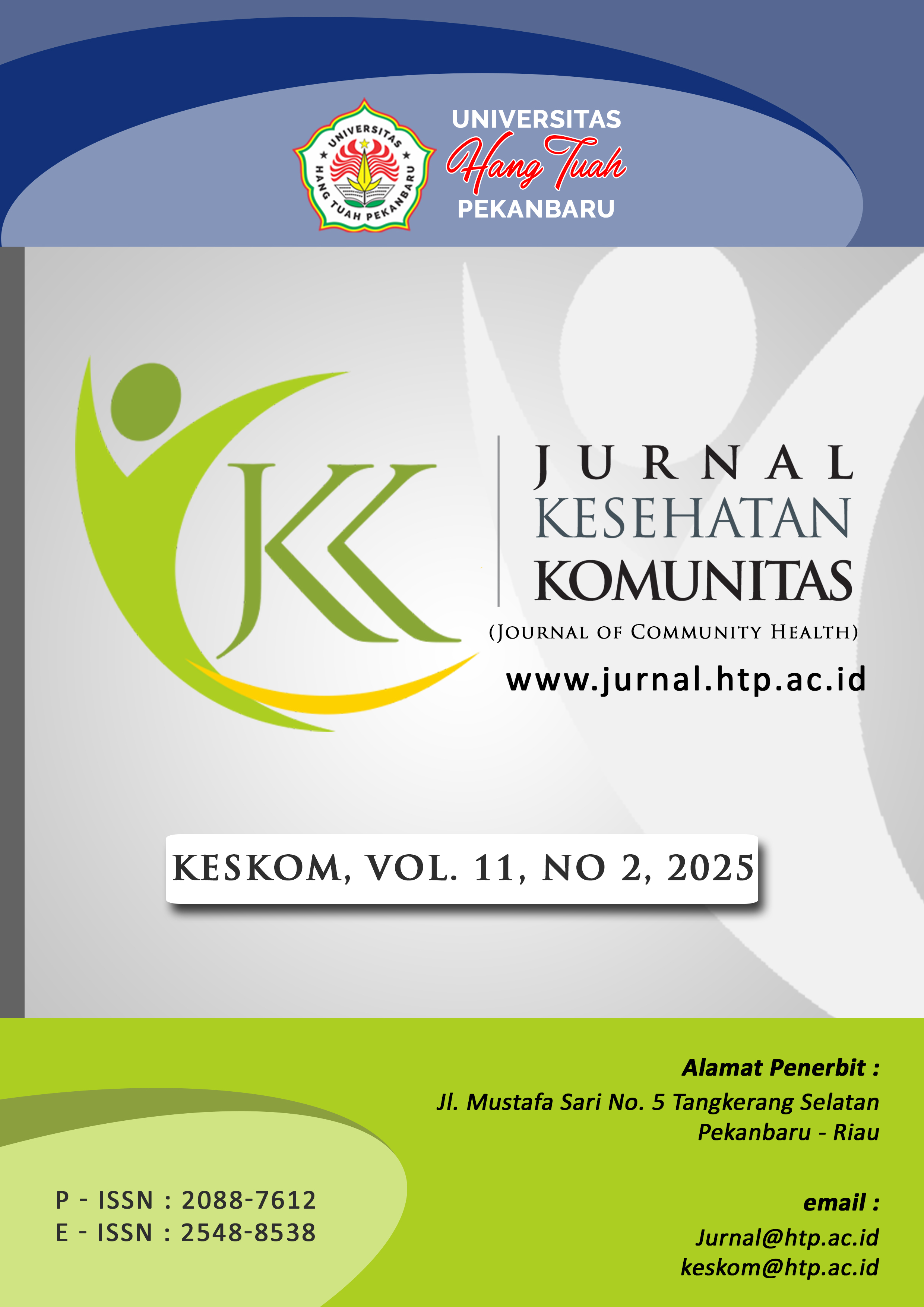Factors Associated with Active Multiple Episode of Malaria in High High-Endemicity Area of Malaria
DOI:
https://doi.org/10.25311/keskom.Vol11.Iss2.2207Keywords:
High endemicity, malaria episode, attitudeAbstract
Background: Timika is an endemic area for malaria in Indonesia. A receptive environment, behavioral factors, and knowledge of the local population cause the high prevalence of malaria in Timika. Objective: This study aims to determine the prevalence of recurrent episodes of malaria and factors that influence malaria episodes in highly endemic areas.Method: This study is an observational study with a cross-sectional design. This study was conducted in Naena Muktipur Village, Timika, Papua. Subjects were obtained using a purposive sampling method that met the inclusion and exclusion criteria. Demographic data, including age, address, ethnicity, education level, and occupation, were obtained through a questionnaire. Results: The subjects were predominantly women, had a high school education, and held non-risky jobs. As many as 72% of subjects had a history of malaria > 1 time, where malaria episodes were related to gender and behavior of staying overnight in the fields. Gender is related to the level of knowledge, while marital status is associated with the level of knowledge and behavior (p <0.05). Conclusion: The prevalence of recurrent episodes in highly endemic areas is still high, where malaria episodes experienced by residents in highly endemic areas are related to factors such as knowledge levels and behavior.
Downloads
References
[1] F. Tairou, S. Nawaz, M. C. Tahita, S. Herrera, B. Faye, and R. C. K. Tine, “Malaria prevention knowledge, attitudes, and practices (KAP) among adolescents living in an area of persistent transmission in Senegal: Results from a cross-sectional study,” PLOS ONE, vol. 17, no. 12, p. e0274656, Dec. 2022, doi: 10.1371/journal.pone.0274656.
[2] WHO, “World malaria report 2024: addressing inequity in the global malaria response,” 2024.
[3] WHO, “World malaria report 2020- WHO,” Cape Town, 2020.
[4] Kemenkes RI, “Situasi terkini perkembangan program pengendalian malaria di Indonesia tahun 2018,” Jakarta, 2018.
[5] S. Lawpoolsri, J. Sattabongkot, and ..., “Epidemiological profiles of recurrent malaria episodes in an endemic area along the Thailand-Myanmar border: a prospective cohort study,” Malar. …, no. Query date: 2024-01-13 03:39:40, 2019, doi: 10.1186/s12936-019-2763-5.
[6] N. Lusiyana and A. F. Agustin, “The Characteristic of Recurrent Malaria Episode: An Observational Study in Timika Papua,” Acta Med Indones, vol. 55, no. 2, pp. 180–186, 2023.
[7] Y. Bediako, R. Adams, A. Reid, J. Valletta, F. Ndungu, and ..., “Repeated clinical malaria episodes are associated with modification of the immune system in children,” BMC Med., no. Query date: 2024-01-13 03:39:40, 2019, doi: 10.1186/s12916-019-1292-y.
[8] M. Kotepui, C. Punsawad, K. U. Kotepui, V. Somsak, N. Phiwklam, and B. PhunPhuech, “Prevalence of malarial recurrence and hematological alteration following the initial drug regimen: a retrospective study in Western Thailand,” BMC Public Health, vol. 19, no. 1, p. 1294, Dec. 2019, doi: 10.1186/s12889-019-7624-1.
[9] D. Parker, R. Tripura, T. Peto, R. Maude, C. Nguon, and ..., “A multi-level spatial analysis of clinical malaria and subclinical Plasmodium infections in Pailin Province, Cambodia,” Heliyon, no. Query date: 2024-01-13 03:39:40, 2017, [Online]. Available: https://www.cell.com/heliyon/pdf/S2405-8440(17)31020-4.pdf
[10] P. Dambach et al., “Nightly Biting Cycles of Anopheles Species in Rural Northwestern Burkina Faso,” J. Med. Entomol., vol. 55, no. 4, pp. 1027–1034, Jun. 2018, doi: 10.1093/jme/tjy043.
[11] E. Esayas et al., “Impact of nighttime human behavior on exposure to malaria vectors and effectiveness of using long-lasting insecticidal nets in the Ethiopian lowlands and highlands,” Parasit. Vectors, vol. 17, no. 1, p. 520, Dec. 2024, doi: 10.1186/s13071-024-06607-9.
[12] Y. Supranelfy and R. Oktarina, “Gambaran Perilaku Pencegahan Penyakit Malaria di Sumatera Selatan (Analisis Lanjut Riskesdas 2018),” Balaba J. Litbang Pengendali. Penyakit Bersumber Binatang Binatang Banjarnegara, pp. 19–28, Jun. 2021, doi: 10.22435/blb.v17i1.3556.
[13] Hermayani and T. Novianty Mansyur, “Tinjauan Literatur Analisis Insidensi Faktor Resiko Kejadian Malaria pada Balita di Wilayah Endemik,” ProHealth J., vol. 21, no. 1, pp. 12–20, Jul. 2024, doi: 10.59802/phj.2024211126.
[14] C. Anumudu, A. Adepoju, M. Adediran, O. Adeoye, and ..., “Malaria prevalence and treatment seeking behaviour of young Nigerian adults,” Ann. Afr. …, no. Query date: 2024-01-13 03:39:40, 2006, [Online]. Available: https://www.ajol.info/index.php/aam/article/view/8380
[15] “Andolina et al. - 2021 - Sources of persistent malaria transmission in a se.pdf.”
[16] N. Astin, A. Alim, and Zainudin, “Studi Kualitatif Perilaku Masyarakat dalam Pencegahan Malaria di Manokwari Barat, Papua Barat, Indonesia,” Jurnal Promkes: The Indonesian Journal of Health Promotion and Health Education, vol. 8, no. 2, pp. 132–145, 2020.
[17] D. Moreno-Gutierrez and ..., “Economic costs analysis of uncomplicated malaria case management in the Peruvian Amazon,” Malar. …, no. Query date: 2024-01-13 03:39:40, 2020, doi: 10.1186/s12936-020-03233-5.
[18] R. D. Guntur, J. Kingsley, and F. M. A. Islam, “Malaria treatment-seeking behaviour and its associated factors: A cross-sectional study in rural East Nusa Tenggara Province, Indonesia,” PLOS ONE, vol. 17, no. 2, p. e0263178, Feb. 2022, doi: 10.1371/journal.pone.0263178.
[19] J. Sattabongkot et al., “Prevalence of asymptomatic Plasmodium infections with sub-microscopic parasite densities in the northwestern border of Thailand: a potential threat to malaria elimination,” Malar. J., vol. 17, no. 1, p. 329, Dec. 2018, doi: 10.1186/s12936-018-2476-1.
[20] E. Ashley and N. White, “The duration of Plasmodium falciparum infections,” Malaria Journal, vol. 13, no. 500, 2014.
Downloads
Submitted
Accepted
Published
How to Cite
Issue
Section
License
Copyright (c) 2025 Jurnal kesehatan komunitas (Journal of community health)

This work is licensed under a Creative Commons Attribution-NonCommercial-ShareAlike 4.0 International License.
Copyright @2017. This is an open-access article distributed under the terms of the Creative Commons Attribution-NonCommercial-ShareAlike 4.0 International License (http://creativecommons.org/licenses/by-nc-sa/4.0/) which permits unrestricted non-commercial used, distribution and reproduction in any medium












































